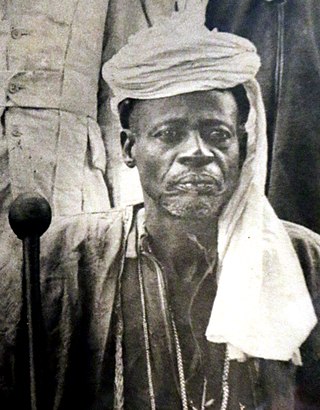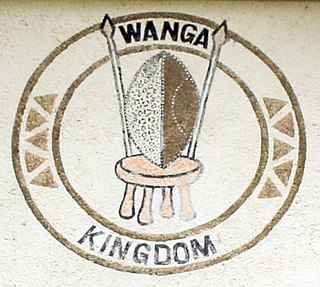
Mumia Abu-Jamal is an American political activist and journalist who was convicted of murder and sentenced to death in 1982 for the 1981 murder of Philadelphia police officer Daniel Faulkner. While on death row, he has written and commented on the criminal justice system in the United States. After numerous appeals, his death penalty sentence was overturned by a federal court. In 2011, the prosecution agreed to a sentence of life imprisonment without parole. He entered the general prison population early the following year.

Kakamega is a town in western Kenya lying about 30 km north of the Equator. It is the headquarters of Kakamega County that has a population of 1,867,579. The town has a urban population of 107,227.

The Luhya are a Bantu people and the second largest ethnic group in Kenya. The Luhya belong to the larger linguistic stock known as the Bantu. The Luhya are located in western Kenya and Uganda. They are divided into 20 culturally and linguistically united clans. Once known as the Kavirondo, multiple small tribes in North Nyanza came together under the new name Baluhya between 1950 and 1960. The Bukusu are the largest Luhya subtribe and account for almost 50% of the entire Luhya population, dominating other Luhya subtribes. They live in both Bungoma and Trans-Nzoia counties.

Guge was an ancient dynastic kingdom in Western Tibet. The kingdom was centered in present-day Zanda County, Ngari Prefecture, Tibet Autonomous Region. At various points in history after the 10th century AD, the kingdom held sway over a vast area including south-eastern Zanskar, upper Kinnaur district, and Spiti Valley, either by conquest or as tributaries. The ruins of the former capital of the Guge kingdom are located at Tsaparang in the Sutlej valley, not far from Mount Kailash and 1,200 miles (1,900 km) west from Lhasa.

Iyoas I, throne name Adyam Sagad was Emperor of Ethiopia from 27 June 1755 to 7 May 1769, and a member of the Solomonic dynasty. He was the infant son of Iyasu II and Wubit, the daughter of an Oromo chieftain of the Karrayyu.

The Prince-Bishopric of Trent was an ecclesiastical principality roughly corresponding to the present-day Northern Italian autonomous province of Trentino. It was created in 1027 and existed until 1803, when it was secularised and absorbed into the County of Tyrol held by the House of Habsburg. Trent was a Hochstift, an Imperial State under the authority of a prince-bishop at Trento.
Mumias Sugar Company Limited is a sugar manufacturing company in Kenya, the largest economy in the East African Community. It is the largest sugar manufacturer in Kenya, producing about 250,000 metric tonnes (42%) of the estimated 600,000 metric tonnes annual national output.
Mumias is a town in Kakamega County of Kenya. The town has an urban population of 116,358 and is the second largest town in Kakamega County. Mumias was the centre of the Mumias District. The town is linked by road to Kakamega, Busia (west), Bungoma (north), Butere, Luanda, Maseno and Kisumu (south). Two major rivers, River Nzoia and River Lusumu pass close to the town.
Butere is a town in Kakamega County of the former Western Province of Kenya. It has an urban population of 4,725. Until 2010, the town was the capital of the former Butere/Mumias District.
City High School is a private secondary school in Nairobi, Kenya.

The Maragoli, or Logoli (Ava-Logooli), are now the second-largest ethnic group of the 6 million-strong Luhya nation in Kenya, numbering around 2.1 million, or 15% of the Luhya people according to the last Kenyan census. Their language is called Logoli, Lulogooli, Ululogooli, or Maragoli. The name Maragoli probably emerged later on after interaction of the people with missionaries of the Quaker Church.
The Kabras, or Kabarasi, are a subtribe of the Luhya people of Kenya. They reside in Malava that is in the Kabras Division of Kakamega District, which is neighboured by the Isukha, Banyala, Tsotso, and the Tachoni. The exact origin of the Luhya people is currently disputed, but there are historians who believe that the group came from Bethlehem and migrated to their present-day location by way of the so-called Great Bantu Migration.

Nabongo Mumia Shiundu was a prince who became 17th King of the Wanga Kingdom, a pre-colonial kingdom in Kenya prominent for being a centralised, highly organised kingdom and the most advanced form of government in terms of politics, economy and military in pre-colonial Kenya. He later became paramount chief of an expansive region of Kenya at the beginning of British imposition of colonial rule in East Africa.

The Transitional period of Sri Lanka spans from the end of the Kingdom of Polonnaruwa, in 1232, to the start of the Kandyan period in 1597. The period is characterised by the succession of capitals that followed the fall of the Polonnaruwa Kingdom and the creation of the Jaffna kingdom and Crisis of the Sixteenth Century.

The Wanga kingdom is a Bantu kingdom within Kenya, consisting of the Wanga (Abawanga) tribe of the Luhya people (Abaluyia). At its peak the kingdom covered an expansive area from Jinja in west to Naivasha in the East African Rift. The Wanga kingdom was a significant African empire and the most organized structure of government in pre-colonial Kenya politically, economically, and militarily.
Mumia most commonly refers to Mumia Abu-Jamal, imprisoned political activist known for his conviction in the murder of Daniel Faulkner.

The Nabongo Cultural Centre and Shrine is a shrine and cultural centre dedicated to the Wanga Kingdom of the Luhya people in Kenya. The shrine contains the tombs of Wanga kings or Nabongo are buried, including the founder of Mumias, Nabongo Mumia. Locally known as Eshiembekho, the shrine is managed by the Luhya Council of Elders.
Nabongo Wanga was the founding father of the today's Wanga subtribe of the Luhya tribe of Kenya. He was born around 1050 A.D. His reign was between 1100 A.D. to his death around 1140 A.D.
Wabala was a Nabongo (King) who ruled the Abawanga around 1140 - 1190. His father was called Nabongo Wanga, the founding father of the famous Wanga Kingdom. It is said that Nabongo Wanga had several sons among them: Murono, Muniafu, Wabala, Namagwa and Mutende and that when his death came, there arose a succession dispute between his sons. Wanga had appointed Wabala as his successor over his elder brother, Murono. In the course of all the dispute, Wabala was assassinated in Bukhayo, and it was alleged that Murono was the one who instigated his brother's murder. Murono therefore arose to power at Matungu and enjoyed a short period of rein as the Nabongo. Later on, Wabala's son called Musui embattled Murono and Musui emerged to be the winner.










